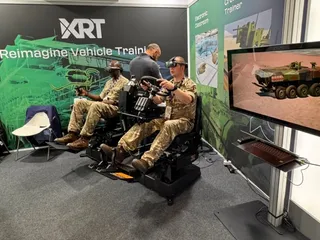A Unique Flight Training Institution
Contact Our Team
For more information about how Halldale can add value to your marketing and promotional campaigns or to discuss event exhibitor and sponsorship opportunities, contact our team to find out more
The Americas -
holly.foster@halldale.com
Rest of World -
jeremy@halldale.com

The ADAC Helicopter Emergency Medical Service Academy is the world’s first integrated training centre for helicopter pilots, emergency doctors and rescue paramedics in the air rescue services. Walter F. Ullrich reports.
The German automobile club ADAC is Europe’s largest motoring organization, and yet it has a subsidiary which one would not expect in an organisation that works in the best interests of motorists: The ADAC HEMS Academy. HEMS stands for “helicopter emergency medical service”, and it is the world’s first integrated training centre for helicopter pilots, emergency doctors and rescue paramedics in the air rescue services.
A Busy Home Base
The ADAC HEMS Academy (AHA) is based in Sankt Augustin, a town near Bonn, the former capital of Germany. It is conveniently located near both Cologne Bonn and Frankfurt airports, and is directly adjacent to the Bonn-Hangelar commercial airport. The site is popular for many, mostly aviation-related institutions. Amateur pilots share the space with fixed- and rotary-wing training schools and aircraft suppliers. The AHA’s sister company, ADAC Luftfahrt Technik (ALT), which specializes in helicopter service and maintenance, is based here as well.
Various governmental organisations are also stationed in Bonn-Hangelar: The Federal Police Headquarters West and the Federal Police Flying Squadron West are adjacent to the airfield. Germany’s counter-terrorism and special operations unit GSG 9 is no doubt the best-known of the AHA’s neighbours, though.
Pioneering
It is in these mostly aeronautical surroundings that the ADAC set up its flight academy. But why does an automobile association in fact need a helicopter training institution? Thomas Gassmann, director Sales & Business Development AHA, has the simple answer: “Because the ADAC, or to be more precise ADAC Luftrettung (Air Rescue), operates helicopters. We at HEMS ensure the high quality standards of the flight crew and medical personnel, which we need in the interests of patient safety.”
The ADAC, founded in 1903, is not only one of the earliest providers of roadside assistance, it is also recognized as being the pioneer of air rescue in Germany. The first civil rescue helicopter went into continuous operation back in 1970. According to ADAC statistics, helicopters belonging to various organizations have flown in excess of 2.2 million missions since the air rescue service was established; around 800,000 of these were ADAC sorties.
Hundreds of thousands of people owe their lives to the availability of rapid airborne medical assistance. With its own fleet of 50 state-of-the-art rescue helicopters and 37 bases across Germany, ADAC Luftrettung has become one of the largest air rescue providers in Europe. Over the years it has evolved from a mere air operator and shuttle service for emergency doctors into an emergency medical services provider. ADAC Luftrettung, which was ISO 9001 certified in April 2008, takes credit for several innovations such as the digital emergency medical protocol and the medical quality management system for air rescue services.
Integrated Training
Heightened environmental awareness and increased educational requirements for trainers and training content led the ADAC to step up the use of flight simulators. Given that it was employing some 150 pilots across the whole of Germany and had a sizeable fleet of helicopters in operation, setting up an own helicopter training centre was only logical. The centre was to replace even more real flying time with flight simulation, thus reducing the real fleet’s flight and maintenance costs. Simulator training is unaffected by weather and daylight hours, and simulation allows critical scenarios to be exercised in the widest spectrum of environmental conditions. Finally, simulators do not emit noise or CO2 – an important argument in an environmentally aware country like Germany. It was therefore clear that the return on the investment of approximately EUR 15m would soon be made.
The centre would also permit training elements to be perfectly adapted to the specific needs of an organization which has air rescue on its banner. That is why, in 2008, ADAC Luftrettung founded the AHA, the world’s first education and training facility for helicopter pilots, emergency doctors and paramedics – all under one roof and based on one concept.
The AHA took up operations in July 2009, beginning with medical training. Since 2011, pilots have been undergoing regular initial and advanced training at the training centre in Hangelar. Training is open to all Eurocopter EC135 and EC145C2 operators (air rescue, law enforcement, off-shore, executive organizations etc.) and has proved to be a true sales and export hit. Today, only 30% of participants come from ADAC Luftrettung; 20% are members of other national air rescue providers, and about half of all participants are with international helicopter operators.
High-Level Training
Rescue pilots are much more likely to have to fly in deteriorating weather conditions and land at unfamiliar or unprepared landing sites. Requirements for air rescue helicopter pilots are, therefore, among the most stringent in aviation. ADAC Luftrettung, for instance, only recruits pilots with a minimum of 1,500 flight hours, including at least 500 hours as a pilot in air rescue or similar operations. Many ADAC pilots come from the German Armed Forces or the police, because they operate within similar flight profiles.
All the training programmes and sessions are conducted in compliance with EASA regulations and encompass proficiency checks (OPC/TRPC), skills tests, type rating training, instrument rating training, recurrent training, CRM training, MCC training and mission-specific flight deployments (HEMS, off-shore, mountain etc.).
The AHA has two full flight simulators (JAR-FSTD H Level A) for EC135 and EC145 helicopters. Both were produced by the UK-based company cueSim Ltd, a subsidiary of QinetiQ. Each simulator features cueSim’s own six-degrees-of-freedom electric motion platform and 10-channel visual system utilizing cueSim’s image-generation software. The projector system ensures realistic projection of all possible weather, lighting and visibility. The AHA leases the simulators under a dry or wet lease agreement, and offers introductory courses to customers who wish to employ their own instructors to train personnel on the AHA’s simulators. Additionally, there are several computer-based training units on site. A variety of interactive programs for the completion of the theoretical education and advanced training, plus theoretical tests are available for trainees.
Specialized Medical Training
Medical education and training mainly addresses personnel from the HEMS sector. For ADAC Luftrettung alone, this involves 280 HEMS crew members and 760 doctors. However, regular emergency transport and hospital staff can also be given full training in emergency and intensive care.
The overall objective is to provide the best care to patients in the environment of a helicopter. Typical skills to be developed in this field are decision-making and correctly setting priorities between flight-operational and medical demands. Additional educational objectives are professional cooperation with other, for instance, ground-based emergency medical services units and personnel, and acting safely and efficiently during special mission profiles. The AHA’s medical courses are based on the guidelines of the DIVI, the German Interdisciplinary Association for Intensive and Emergency Medicine. In addition to these courses, the AHA also provides basic and refresher courses in health care management for rescue helicopter and intensive care helicopter services.
The AHA uses a well-equipped medical simulator (Christoph Sim) to train doctors and paramedics. Christoph Sim is a 1:1 wooden mock-up of an EC135. It has the full range of equipment found in a rescue and intense care unit, and also features an audio and video installation to monitor training. A second mock-up, which replicates a BK117 helicopter, is primarily used for decentralized training at regional stations. Training on the Academy’s mock-up helicopters enables realistic professional and further training. State-of-the-art patient simulators, a clinical shock room simulator which can be used as an intensive care room, two simulation control rooms and a large seminar room for up to 40 participants are also available at the medical training facility.
Combined Training
The AHA offers initial and refresher training to technical crew members (TCMs). These TCMs handle demanding tasks which require specialist knowledge in both the aeronautical and the medical field. Although they are not helicopter pilots, they assist the pilot before and during the flight; at the site of operation they support the emergency doctor.
Further, the AHA provides aeromedical crew resource management (ACRM) training based on the fundamentals of classic crew resource management (CRM). CRM generally aims to sustainably improve non-technical skills, of the crew members and on-board personnel. This includes communication, teamwork, leadership, situation awareness and decision-making. In HEMS, the medical requirements are included as an important part of the mission, and encompass the emergency doctor as a medical team member. AHA training sessions can reproduce the complete rescue chain from roadside medical treatment to intensive care in hospital, and may even include real personnel and equipment from other rescue providers, fire brigade or civil protection, etc.
This common training concept contributes to team-building, building mutual trust and a common mental model, which in the end creates positive effects for flight and patient safety. CRM is compulsory for pilots and crew members in HEMS.
Adapting & Developing
The AHA’s integrated training for helicopter pilots, emergency doctors and paramedics in air rescue services has proven successful. Training courses are fully booked, with participants from 14 European operators regularly taking part. The unique training opportunities also attract clients from further afield, for example from Argentina, Brazil, Australia, China and Japan.
In 2014 the ADAC began introducing a new helicopter, the H145 (former EC145 T2). Training equipment will subsequently be adapted to include the new aircraft. To that end, the AHA entered into a comprehensive cooperation with Reiser Simulation and Training GmbH (see sidebar). According to Thomas Gassmann, things will get tight in the hangar when the FFS for the H145 arrives in 2017: “For a transitional period, we will have to live with a makeshift. But in 2018 our medical training branch will move into a newly built facility right next door at our sister company ALT.”
These expansion and renovation measures will further expand the AHA’s customer base and strengthen the ADAC HEMS Academy’s unique position as a provider of integrated training for air rescue helicopter operators, and intensive care medicine at large.
FFS H145
In January 2015 the ADAC HEMS Academy and Reiser Simulation and Training announced a long-term cooperation. It provides that Reiser will build a fullflight simulator for the H145 helicopter and will lease it to the HEMS Academy for 15 years. In return, the Academy will guarantee a certain number of flight hours. The simulator will be delivered in 2017. The newly established Reiser Training Services GmbH will provide logistic services related to this contract on an availability basis.
Meanwhile, Reiser has successfully completed flight data acquisition and is now developing a Level D FFS flight model. Reiser will also develop the avionics software. The simulator will be provided with LED projectors to guarantee low life-cycle costs. It will feature a CGF system which realistically replicates people, crowds, ambulances, accident situations and complex HEMS environments. Apart from the full flight simulator, Reiser will produce the full range of training equipment for the helicopter, including CPT, FNPT and FTD for interested customers.


